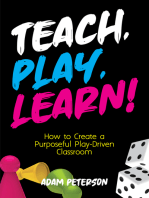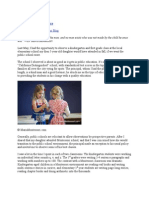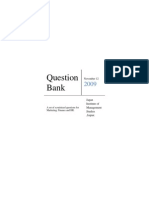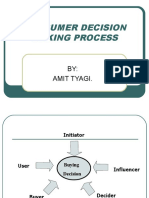0 ratings0% found this document useful (0 votes)
99 viewsArticle
Article
Uploaded by
m0nicmThe document discusses how creativity in children is often stifled through various "creativity killers" in schools. Some key creativity killers identified are surveillance, evaluation, excessive rewards, competition, over-control of children, restricting choice, and pressure. The most subtle killer is lack of time - children need open-ended time to fully explore their interests and talents. However, children are often rushed through activities and interrupted before they can fully engage in creative flow. Allowing children freedom and time to follow their natural inclinations is important to nurture creativity.
Copyright:
© All Rights Reserved
Available Formats
Download as PDF, TXT or read online from Scribd
Article
Article
Uploaded by
m0nicm0 ratings0% found this document useful (0 votes)
99 views4 pagesThe document discusses how creativity in children is often stifled through various "creativity killers" in schools. Some key creativity killers identified are surveillance, evaluation, excessive rewards, competition, over-control of children, restricting choice, and pressure. The most subtle killer is lack of time - children need open-ended time to fully explore their interests and talents. However, children are often rushed through activities and interrupted before they can fully engage in creative flow. Allowing children freedom and time to follow their natural inclinations is important to nurture creativity.
Copyright
© © All Rights Reserved
Available Formats
PDF, TXT or read online from Scribd
Share this document
Did you find this document useful?
Is this content inappropriate?
The document discusses how creativity in children is often stifled through various "creativity killers" in schools. Some key creativity killers identified are surveillance, evaluation, excessive rewards, competition, over-control of children, restricting choice, and pressure. The most subtle killer is lack of time - children need open-ended time to fully explore their interests and talents. However, children are often rushed through activities and interrupted before they can fully engage in creative flow. Allowing children freedom and time to follow their natural inclinations is important to nurture creativity.
Copyright:
© All Rights Reserved
Available Formats
Download as PDF, TXT or read online from Scribd
Download as pdf or txt
0 ratings0% found this document useful (0 votes)
99 views4 pagesArticle
Article
Uploaded by
m0nicmThe document discusses how creativity in children is often stifled through various "creativity killers" in schools. Some key creativity killers identified are surveillance, evaluation, excessive rewards, competition, over-control of children, restricting choice, and pressure. The most subtle killer is lack of time - children need open-ended time to fully explore their interests and talents. However, children are often rushed through activities and interrupted before they can fully engage in creative flow. Allowing children freedom and time to follow their natural inclinations is important to nurture creativity.
Copyright:
© All Rights Reserved
Available Formats
Download as PDF, TXT or read online from Scribd
Download as pdf or txt
You are on page 1of 4
The Creative Spirit
by Dan Goleman, Paul Kaufman, and Michael Bay
Ir cne,trtvltv is a child's natural state, what happens on the way to
adulthood? Many of us will recognize ourselves in the sad tale of little
Teresa Amabile, now a specialist in creativity.
"I was in kindergarten and my beloved teacher, Mrs. Bollier, had
come to our home for an end-of-the-year conference with my mother.
And, of course, I was eavesdropping on this conference from the next
room."
Teresa was thrilled to hear Mrs. Bollier tell her mothet
"I think
Teresa shows a lot of potential for artistic creativit and I hope that's
something she really develops over the years."
"I didn't know what 'creativity' was," she recalls,
"but
it sure
sounded like a good thing to have.
"When I was in kindergarten," she went on, "I remember rushing in
every da very excited about getting to the easel and playing with all
these bright colors and these big paintbrushes we had. And there was
a clay table set up where we had free access to all these art materials. I
remember going home every day after kindergarten and telling my
mother I wanted to play with crayons, I wanted to draw, I wanted to
paint."
But kindergarten was to be the high point of Teresa's artistic career.
The next year she entered a strict, traditional school, and things began
to change. As she tells it, "Instead of having free access to art materials
every da art became just
another subject, something that you had for
an hour and a half every Friday afternoon."
Week after week, all through elementary school, it was the same art
class. And a very restricted, even demoralizing one at that. "We would
be given small reprints of one of the masterworks in painting, a differ-
ent one every week. So, for example, I remember one week in second
grade, we all got a small copy of da Vinci's Adoration of the Magi.
"This was meant for art appreciation, but that's not how our
teacher used it. Instead we were told to take out our materials and
copy it. Second-graders being asked to copy da Vinci-with their
loose-leaf paper and their Crayola crayons. An exercise in frustration!
"You don't have the skill development at that age to even make all
those horses and angels fit on the page, let alone make them look like
anything. It was very demoralizing. You could see yourself that what
you were doing was very bad.
UNIT 4 READING SELECTION IA
.
97
"We weren't given any help developing skills. Worse, we were graded
on these monstrosities that we produced, so we felt a healy evaluation
pressure. I was really aware at the time that my motivation for doing
artwork was being completely wiped out. I no longer wanted to go
home at the end of the day and take out my art materials and draw or
paint."
THE CREATIVITY KILTERS
TrE
psvcsoLocrcAL pREssuRES
that inhibit a child's creativity
occur early in life. Most children in preschool, kindergarten-even in
first grade-love being in school. They are excited about exploring
and learning. But by the time ey are in the third or fourth grade,
many don t like school, let alone have any sense of pleasure in their
own creatitF.
Dr. Amabile's research has identified the main creativity killers:
Surveillanc: hovering over kids, making them feel that they're
constantly being watched while they're working. When a child is under
constant observation, the risk-taking, creative urge goes underground
and hides.
Evaluation: making kids worry about how others
judge
what they're
doing. Kids should be concerned primarily with how satisfied they are
with their accomplishments, rather than focusing on how they are being
evaluated or graded, or what their peers will think.
o
Rewards: excessive use of prizes, such as gold stars, money, or
toys. If overused, rewards deprive a child of the intrinsic pleasure of
creative activity.
o
Gompetition: putting kids in a desperate win-lose situation, where
only one person can come out on top. Children should be allowed to
progress at their own rate. (There can, however, be healthy competi-
tion that fosters team or group spirit.)
Over-control: telling kids exactly how to do things-their school-
work, their chores, even their play. Parents and teachers often confuse
this kind of micromanagement with their duty to instruct. This leaves
children feeling that any originality is a mistake and any exploration a
waste of time.
o
Bestricting Ghoice: telling children which activities they should
engage in instead of letting them follow where their curiosity and pas-
sion lead. Better to let a child choose what is of interest, and support
that inclination.
o
Pressure: establishing grandiose expectations for a childt per-
formance. For example, those "hothouse" training regimes that force
toddlers to learn the alphabet or math before they have any real interest
98
.
READING SELECTION IA UNIT
can easily back_fire and end up instilling an aversion for the subject
being taught.
One of the greatest creativity killers, however, is more subtle and so
deeply rooted in our culture that it is hardly noticed. It has to do with
time.
If intrinsic motivation is one key to a childt creativiry the crucial
element in cultivating it is time: open-ended time for the child to savor
and explore a particular
activity or material to make it his or her own.
Perhaps one of the greatest crimes adults commit against a child's cre-
ativity is robbing the child of such time.
Children more naturally than adults enter that ultimate state of cre-
ativity called
flow,
in which total absorption can engender peak plea-
sure and creativity. In flow, time does not matter; there is only the
timeless moment at hand. It is a state that is more comfortable for
children than adults, who are more conscious of the passage of time.
"One ingredient of creativity is open-ended time," says Ann Lewin,
Director of the Capital Childrens Museum in Washington, D.C. The
childrent museum is an arena designed to draw children into the flow
state. But, as Lewin sees there every day, there is a marked difference
between the rhythms of the children who come there and the adults
who bring them.
"Children
have the capacity to get lost in whatever thdre doing in
a way that is much harder for an adult," she says. "Children need the
opportunity to follow their natural inclinations, their own particular
talents, to go wherever their proclivities lead them."
Unfortunatel children are interrupted, torn out of deep concen-
tration; their desire to work somerhing through is frustrated. Lewin
explains: "Adults have the compulsion to march through and see
everything. But there are hundreds ofthings that can deeply engross a
child here, things they can spend hours with. And you see the adults
pulling them awa tugging at them and telling them,'Enough, stop it,
let's go.'
"It's a terribly frustrating thing to be stopped when you're in the
middle of the process, But we live in such a hurry-up way. So again
and again children are stopped in the middle of things they love to do.
They are scheduled. There isn't the time for children ro relax into their
own rhythm."
UNIT 4 READING SELECTION 1A
.
99
13.
-
Children musr learn to follow rhe rules of sociery.
14.
-
Competition is essential for eflective learning.
15.
-
If children are left on their own they will waste time.
16.
-
If children are encouraged to explore their interesm, they will
eventually learn everything thar is important.
Selection 1A Reference Book
Before You Begin Take a few minutes to think about the following questions before you read
the selection on pages 97-99.
1. Can you describe the conditions under which you do your best work?
2. \X/hat are your favorite memories of school? Your least favorite memories?
3. How would you organize schools to encourage creativity and learning?
Beginning on page 97 is an excerpt from a book written for the layperson (the
nonprofessional, such
as a parent, a grandparent, or an everyday citizen) who is interested in teaching and learning. Read ir
and answer the questions that follow. Your teacher may want you to do the Vocabulary from Context
exercise on pages 101-2 before you begin reading.
Comprehension
Answer the following questions according to your understanding of the authors' point of view True/False iten::
are indicated by aT I F preceding the statement.
1. \flhat are the
"creativity
killers" the authors discuss?
2. T I F It is difficult to be creative when you are being observed.
3. T I F Telling learners that they are doing a good job may hinder their creativiry.
4. T I F You should never reward a student for his or her accomplishments.
5. Do you think competition helps or hinders creativiry? Give examples from your own experience.
6. T / F Creativityrequires freedom.
7. T I F Teachers who want to encourage creativiry should limit student choice.
8. T / F Unreasonably high expectations can reduce creativiry.
9. T / F It is difficult to be creative on someone else's schedule.
96
.
READING SELECTION 1A UNIT 4
You might also like
- The Language of Art: Reggio-Inspired Studio Practices in Early Childhood SettingsFrom EverandThe Language of Art: Reggio-Inspired Studio Practices in Early Childhood SettingsRating: 5 out of 5 stars5/5 (1)
- The Creative SpiritDocument3 pagesThe Creative SpiritAdolfo Antonio González Pino0% (2)
- The Call of the Wild and Free: Reclaiming the Wonder in Your Child's Education, A New Way to HomeschoolFrom EverandThe Call of the Wild and Free: Reclaiming the Wonder in Your Child's Education, A New Way to HomeschoolRating: 4.5 out of 5 stars4.5/5 (33)
- HomeschoolDocument154 pagesHomeschoolLuiza Hernández100% (20)
- Teach, Play, Learn!: How to Create a Purposeful Play-Driven ClassroomFrom EverandTeach, Play, Learn!: How to Create a Purposeful Play-Driven ClassroomNo ratings yet
- ECO320 Practice Test QuestionsDocument11 pagesECO320 Practice Test QuestionsANNIENo ratings yet
- Maker Camp: Heritage Crafts and Skill-Building Projects for KidsFrom EverandMaker Camp: Heritage Crafts and Skill-Building Projects for KidsNo ratings yet
- Reggio ArticleDocument4 pagesReggio Articleapi-264474189No ratings yet
- The Vital Role of Play in Early Childhood Education by Joan AlmonDocument35 pagesThe Vital Role of Play in Early Childhood Education by Joan AlmonPlanning Docs100% (1)
- How to Teach Kids to Read in 2020+ - Working In Changing Times With Challenged ChildrenFrom EverandHow to Teach Kids to Read in 2020+ - Working In Changing Times With Challenged ChildrenRating: 5 out of 5 stars5/5 (2)
- F for Failure: A Critical Examination of the Ineradicable Defects of Canadian EducationFrom EverandF for Failure: A Critical Examination of the Ineradicable Defects of Canadian EducationNo ratings yet
- A TeacherDocument46 pagesA TeacherPollyana TanaleonNo ratings yet
- The Lion Cubs: Institution Building For Supplementary Education)Document13 pagesThe Lion Cubs: Institution Building For Supplementary Education)kwampokuNo ratings yet
- Letting Them Lead: Adventures In Game-Based, Self-Directed LearningFrom EverandLetting Them Lead: Adventures In Game-Based, Self-Directed LearningNo ratings yet
- Play Today: Building the Young Brain through Creative ExpressionFrom EverandPlay Today: Building the Young Brain through Creative ExpressionNo ratings yet
- The Joy of Slow: Restoring Balance and Wonder to Homeschool LearningFrom EverandThe Joy of Slow: Restoring Balance and Wonder to Homeschool LearningNo ratings yet
- What Your Child Will Learn in Our Pre-KDocument14 pagesWhat Your Child Will Learn in Our Pre-KLes Du Plessis BassetNo ratings yet
- John Holt's 8 Great Ideas About Unschooling.Document36 pagesJohn Holt's 8 Great Ideas About Unschooling.radek.chaladajNo ratings yet
- Ahaparenting Com-Nurturing Your Childs CreativityDocument3 pagesAhaparenting Com-Nurturing Your Childs Creativityapi-235137283No ratings yet
- NeillDocument3 pagesNeillRoxana SahanaNo ratings yet
- The Missing Alphabet: A Parents' Guide to Developing Creative Thinking in KidsFrom EverandThe Missing Alphabet: A Parents' Guide to Developing Creative Thinking in KidsRating: 3.5 out of 5 stars3.5/5 (4)
- Curiosity and Wonder: Cue Into Children's Inborn Motivation To LearnDocument3 pagesCuriosity and Wonder: Cue Into Children's Inborn Motivation To LearnPrasoon PremrajNo ratings yet
- Listening X-TH FormDocument19 pagesListening X-TH FormNataliaNo ratings yet
- Pub Pursuasivespeech JensenDocument4 pagesPub Pursuasivespeech Jensenapi-531601306No ratings yet
- The Fundamental Choice Montessori ArticleDocument9 pagesThe Fundamental Choice Montessori Articleapi-264474189No ratings yet
- Spotlight On Play 21-1Document5 pagesSpotlight On Play 21-1api-238210311No ratings yet
- Science in The Preschool ClassroomDocument7 pagesScience in The Preschool ClassroomAgung Dirgo NugrohoNo ratings yet
- 101 Activities for Kids in Tight Spaces: At the Doctor's Office, on Car, Train, and Plane Trips, Home Sick in Bed . . .From Everand101 Activities for Kids in Tight Spaces: At the Doctor's Office, on Car, Train, and Plane Trips, Home Sick in Bed . . .Rating: 4 out of 5 stars4/5 (1)
- How to Teach Autistic Children More Effectively Using Educational Psychology and My Own Experiences and KnowledgeFrom EverandHow to Teach Autistic Children More Effectively Using Educational Psychology and My Own Experiences and KnowledgeNo ratings yet
- Creativity in Young ChildrenDocument8 pagesCreativity in Young Childrennurlaila.ahmadNo ratings yet
- Nurturing Next-Generation Innovators: Open-Ended Activities to Support Global ThinkingFrom EverandNurturing Next-Generation Innovators: Open-Ended Activities to Support Global ThinkingNo ratings yet
- Cultivating the Genius of Black Children: Strategies to Close the Achievement Gap in the Early YearsFrom EverandCultivating the Genius of Black Children: Strategies to Close the Achievement Gap in the Early YearsRating: 4 out of 5 stars4/5 (2)
- The Artful Parent: Simple Ways to Fill Your Family's Life with Art and CreativityFrom EverandThe Artful Parent: Simple Ways to Fill Your Family's Life with Art and CreativityRating: 4.5 out of 5 stars4.5/5 (10)
- School Is Bad For ChildrenDocument4 pagesSchool Is Bad For ChildrenJuan TropaNo ratings yet
- Part 2: Demonstrate How You Would Get Children To Appreciate ArtDocument6 pagesPart 2: Demonstrate How You Would Get Children To Appreciate ArtIshini EkanayakeNo ratings yet
- Your Child: Today and Tomorrow Some Problems for Parents Concerning Punishment, Reasoning, Lies, Ideals and Ambitions, Fear, Work and Play, Imagination, Social Activities, Obedience, Adolescence, Will, HeredityFrom EverandYour Child: Today and Tomorrow Some Problems for Parents Concerning Punishment, Reasoning, Lies, Ideals and Ambitions, Fear, Work and Play, Imagination, Social Activities, Obedience, Adolescence, Will, HeredityNo ratings yet
- Give Childhood Back To Children If We Want Our Offspring To Have Happy Productive and Moral Lives We Must Allow More Time For Play, Not LessDocument6 pagesGive Childhood Back To Children If We Want Our Offspring To Have Happy Productive and Moral Lives We Must Allow More Time For Play, Not LessKumail HaiderNo ratings yet
- Facilitator's Guide: Focused Psychosocial Support On Child LaborDocument16 pagesFacilitator's Guide: Focused Psychosocial Support On Child LaborOmar Hindi ZakariaNo ratings yet
- Teaching StrategiesDocument26 pagesTeaching StrategiesAlluri Appa RaoNo ratings yet
- Ready, Set, Read: Building a Love of Letters and Literacy Through Fun Phonics ActivitiesFrom EverandReady, Set, Read: Building a Love of Letters and Literacy Through Fun Phonics ActivitiesRating: 4.5 out of 5 stars4.5/5 (3)
- 19 - On Growing Without Schooling PDFDocument2 pages19 - On Growing Without Schooling PDFHirenkumar100% (1)
- Embracing Math: Cultivating a Mindset for Exploring and LearningFrom EverandEmbracing Math: Cultivating a Mindset for Exploring and LearningNo ratings yet
- Schools Kill Creativity by DuyDocument2 pagesSchools Kill Creativity by Duyduyphammm1203No ratings yet
- Developmentally Appropriate PracticesDocument21 pagesDevelopmentally Appropriate PracticesTimoy Cajes83% (6)
- Pillars of EducationDocument6 pagesPillars of EducationExcel Joy MarticioNo ratings yet
- Curiosity Can Be Described AsDocument3 pagesCuriosity Can Be Described AsPrincess SamNo ratings yet
- Young Readers and Their Cultural ConnectionsDocument12 pagesYoung Readers and Their Cultural ConnectionsPhillip ReadeNo ratings yet
- TinkerLab Art Starts: 52 Projects for Open-Ended ExplorationFrom EverandTinkerLab Art Starts: 52 Projects for Open-Ended ExplorationNo ratings yet
- Strengths Based Parenting: Developing Your Children's Innate TalentsFrom EverandStrengths Based Parenting: Developing Your Children's Innate TalentsNo ratings yet
- Montessori Vs WaldorfDocument4 pagesMontessori Vs WaldorfAbarnaNo ratings yet
- The Importance of Art in Child DevelopmentDocument4 pagesThe Importance of Art in Child Developmentapi-366987437No ratings yet
- Crohn DiseaseDocument16 pagesCrohn DiseaseDanielhasNo ratings yet
- Primary - 6 Geography Chapter - 6Document14 pagesPrimary - 6 Geography Chapter - 6KHAING LYNNNo ratings yet
- Ancient History of MP English 35Document8 pagesAncient History of MP English 35sharman2102No ratings yet
- Biscuit Industry: Comprehensive ReportDocument9 pagesBiscuit Industry: Comprehensive Reportsakthivel vengatasamyNo ratings yet
- History of Al-Hijaz (1520-1632)Document76 pagesHistory of Al-Hijaz (1520-1632)TrollNopeNo ratings yet
- Micon Ic Check SheetDocument3 pagesMicon Ic Check SheetVenkatesh Subramanya0% (1)
- 1 s2.0 S0753332216313294 MainDocument12 pages1 s2.0 S0753332216313294 MainMariaNo ratings yet
- Tadano TM 1800 PDFDocument151 pagesTadano TM 1800 PDFharoun100% (1)
- Specifications: Radio: 4-5 Channel System Weight: 6 - 6.75 LB Wing LoadingDocument40 pagesSpecifications: Radio: 4-5 Channel System Weight: 6 - 6.75 LB Wing LoadingMarian GrigoreNo ratings yet
- Guidance For Midterm #1Document2 pagesGuidance For Midterm #1dinojerkNo ratings yet
- The Effectiveness of Durian Peel As A Multi-Mycotoxin AdsorbentDocument18 pagesThe Effectiveness of Durian Peel As A Multi-Mycotoxin AdsorbentMobarak GumamaNo ratings yet
- Parable of Pharisee and PublicanDocument16 pagesParable of Pharisee and PublicanRandy NealNo ratings yet
- CATALOGUE Biosynex 2021-ExportDocument56 pagesCATALOGUE Biosynex 2021-ExportHaitham Salama GhareebNo ratings yet
- Dy23 2, Dy27 2, Ep5754aDocument30 pagesDy23 2, Dy27 2, Ep5754anijosoNo ratings yet
- Pump-Pipe Systems Design-1Document64 pagesPump-Pipe Systems Design-1Neetor TendekayiNo ratings yet
- Question BankDocument71 pagesQuestion BankchandrulesNo ratings yet
- IEI R3 L19 InfoDocument6 pagesIEI R3 L19 InfoEduardo Ruiz ZapataNo ratings yet
- Chapter 1: Introduction: School Management SystemDocument7 pagesChapter 1: Introduction: School Management SystemHissey BhutiaNo ratings yet
- Financial EconomicsDocument14 pagesFinancial EconomicsLechisa BekeleNo ratings yet
- Controlling of Automatic Packing and Loading System On Cement PlantDocument92 pagesControlling of Automatic Packing and Loading System On Cement PlantTesfay GebreslassieNo ratings yet
- Business Intelligence in The Era of Big Data and Cognitive BusinessDocument32 pagesBusiness Intelligence in The Era of Big Data and Cognitive BusinessNicole DoaneNo ratings yet
- Using Analytics To Align Sales and Marketing TeamsDocument6 pagesUsing Analytics To Align Sales and Marketing TeamsDiana ParraNo ratings yet
- What Is SS?Document3 pagesWhat Is SS?qwdfghNo ratings yet
- Sand Production Lecture 1Document20 pagesSand Production Lecture 1Mustafa AlrikabiNo ratings yet
- Ayala - Teleological Explanations in Evolutionary BiologyDocument16 pagesAyala - Teleological Explanations in Evolutionary BiologyRodrigo CarvalhoNo ratings yet
- Lesson 6 The Globalization of ReligionDocument22 pagesLesson 6 The Globalization of ReligionJhera ArabNo ratings yet
- Pagan and Christian Rome by Lanciani, RodolfoDocument248 pagesPagan and Christian Rome by Lanciani, RodolfoGutenberg.orgNo ratings yet
- Consumer Decision Making Process: BY: Amit TyagiDocument19 pagesConsumer Decision Making Process: BY: Amit Tyagianandraj161No ratings yet
- Alstom ContactorsDocument8 pagesAlstom Contactorshassan karimiNo ratings yet

























































































